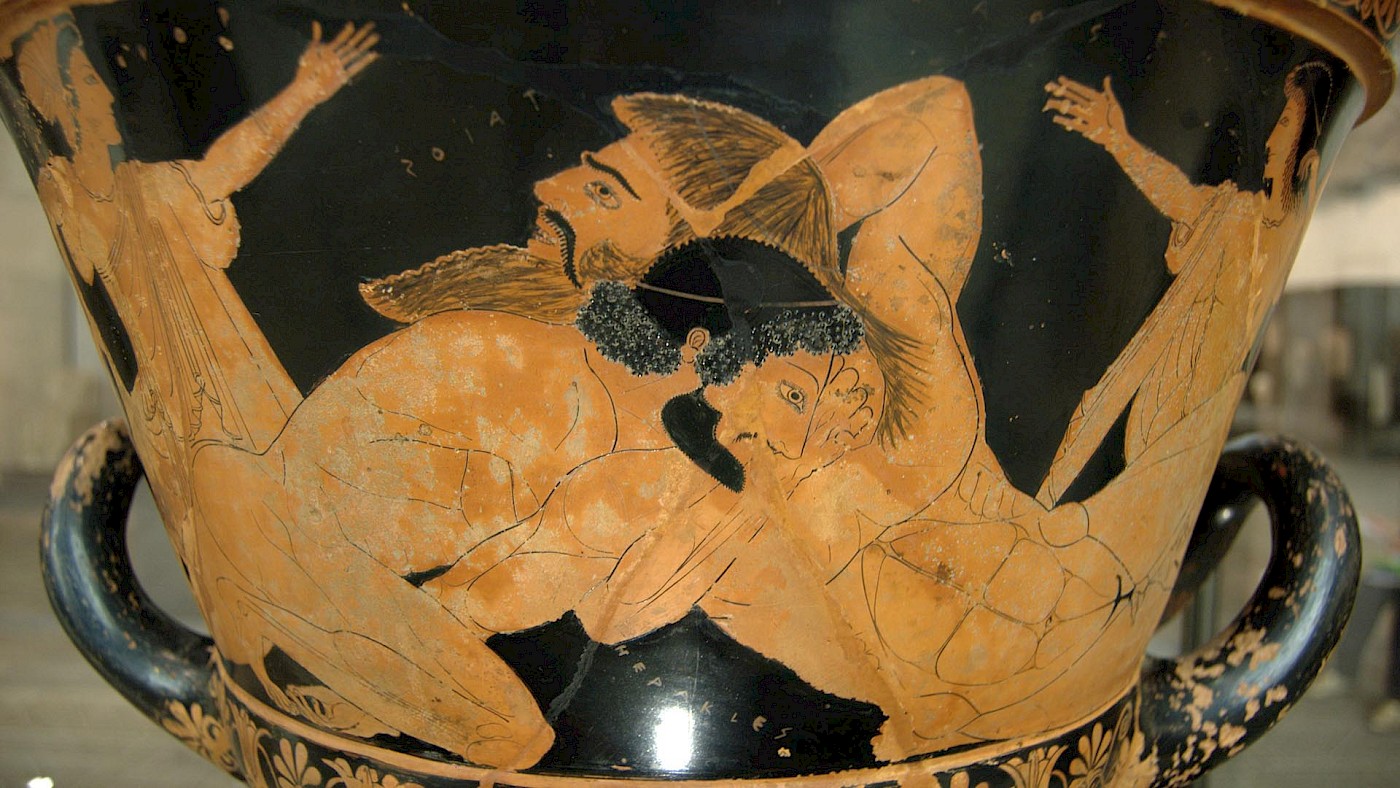By the end of the Archaic period (800-480 BCE), the ancient Greeks had already established significant and lasting connections to North Africa. As part of the broader process of Greek settlement throughout the Mediterranean and beyond, Greek cities were established in both Libya and Egypt.
The existence of settlements at Cyrene (and elsewhere) in the former and Naukratis in the latter penetrated the imagination of ancient Greek writers and artists. One result is that beginning in the sixth century BCE, mythological figures such as the Libyan earth-giant Antaios and the Egyptian pharaoh Busiris make appearances in both text and art in confrontations with the hero Herakles.
On red-figure and black-figure vessels made by Greek potters and vase-painters, Herakles fights Antaios and Busiris with his priests in separate vignettes set in Libya and Egypt respectively; superficially, the images seem to reinforce the idea of a Greek and non-Greek binary.
As I hope to show, however, the relationship between the Greeks and North Africa is far more complex. An extended examination of the objects in question and the circumstances that allowed for their creation is necessary to achieve a nuanced understanding.
Herakles, Antaios, and Busiris in Greek mythology
To begin, some background on the three mythological figures. The Greek hero Herakles, of course, is one of the best-known ancient Greek heroes both in antiquity and in the present. The son of the chief Olympian god, Zeus, and the mortal woman, Alcmene, Herakles is often portrayed in the context of one of his Twelve Labors (athloi), such as the slaying of monsters including the Nemean Lion or the Lernaean Hydra (Brommer 1986, pp.7, 12-13; Stafford 2012, pp. 30-32, 33-35).
There are also minor feats (parerga) involving the hero, and the Antaios and Busiris myths belong to this category, although both are associated with the eleventh Labor of retrieving the Apples of the Hesperides (Brommer 1986, pp. 49-50; Stafford 2012, pp. 46-47).
The majority of the literary references to Antaios and Busiris in both Greek and Latin are either fragmentary or lost, including many of the early examples from the fifth century BCE (Livingstone 2001, pp. 78-80). Antaios is mentioned in Pindar’s ode Isthmian 4 (4.52-5) from the early fifth century BCE. Busiris was the subject of several Athenian comedies toward the middle of the same century and in the fourth century BCE he is central in Isocrates’ Busiris, wherein the orator employs the pharaoh in a parodic rhetorical exercise (Livingstone 2001, p. 54).
In addition, the myth receives a dismissive treatment from Herodotus in book two of the Histories (2.45). The most complete versions that survive are much later and reside in book two of Pseudo-Apollodorus’s Library of Greek Mythology (Bibliotheca) from the second century CE, where the author places them together chronologically (2.5.11; Loeb Classical Library translation by J.G. Frazer from 1921):
Being informed, he traversed Libya. That country was then ruled by Antaeus, son of Poseidon, who used to kill strangers by forcing them to wrestle. Being forced to wrestle with him, Hercules hugged him, lifted him aloft, broke and killed him; for when he touched earth so it was that he waxed stronger, wherefore some said that he was a son of Earth.
After Libya he traversed Egypt. That country was then ruled by Busiris, a son of Poseidon by Lysianassa, daughter of Epaphus. This Busiris used to sacrifice strangers on an altar of Zeus in accordance with a certain oracle. For Egypt was visited with dearth for nine years, and Phrasius, a learned seer who had come from Cyprus, said that the dearth would cease if they slaughtered a stranger man in honor of Zeus every year. Busiris began by slaughtering the seer himself and continued to slaughter the strangers who landed. So Hercules also was seized and haled to the altars, but he burst his bonds and slew both Busiris and his son Amphidamas.
Although the earliest occurrences of the episodes in vase-painting were made at least a half-century earlier than any of the known literary sources, there are aspects present in both text and art: the wrestling match between Herakles and Antaios and Herakles’ killing of Busiris and his priests at the altar of Zeus.
Since many of the visual representations were produced before any written version, it is important to keep in mind that they are not illustrations of texts. Rather, the vase-painters’ creations are based on their direct experience of myth, which was in all likelihood largely visual, aural, and oral.
Antaios and Busiris in Greek vase-painting
Ancient Greek potters and vase-painters first produced ceramics decorated with Antaios and Busiris imagery just after the middle of the sixth century BCE. Vases bearing the depictions survive in roughly equal numbers, with just under forty instances of each.
The latest of the Antaios portrayals belong to the middle of the fifth century BCE, and for Busiris, the fourth century BCE. Antaios remained a popular figure in other artistic media in later centuries well into the Roman period, but Busiris only ever appears in Greek vase-painting.
The myths are found in both the black-figure and red-figure techniques, but in different proportions. In black-figure, where a black silhouette of clay-and-water slip was applied to the surface of the vessel and then incised to add detail before firing in a kiln, there are more examples of Antaios.
The reverse is true for Busiris, which occurs more often in red-figure, wherein the red-orange clay of a vase’s body was employed to create the figures by applying slip in varying consistencies to elaborate the details. The limited palette created technical constraints in that it was not possible to show physical difference via skin color, as the human figures are uniformly red-orange or black depending on the technique. Instead, the artists emphasized other distinctions which I discuss below.
In terms of the types of ceramics preferred by the artists, there is consistency that tells us about function. Kraters (mixing vessels for water and wine), kylikes (drinking cups), amphorae (for storing liquids), pelikai (also for storing liquids), stamnoi (for serving liquids), and hydriae (water jars) make up the bulk of the examples.
Most of the pottery shapes of this kind were used for the consumption of wine, making them paraphernalia of the symposion. Against the backdrop of that elite male drinking party, a common interpretation makes them a means for encountering or playing the “other” (Lissarrague 2002, pp. 108-109).
Such a view is certainly valid, but it is important to note that it applies only to the Greek use of the objects. When the archaeological context is known it is often the case that the vases come from Etruria in modern Italy, which in antiquity was home to the Etruscans, a civilization made up of numerous towns and cities.
There is no consensus on what it was in particular about Greek vases that so fascinated the Etruscans. As a non-Greek audience, they complicate the interpretation of objects and iconography by precluding a single, neat reading of the “other.” This is doubly true given that in the eyes of the Greeks, Etruscans were themselves “other,” and it is unclear how they read such objects.
Turning now to the images, there are several elements shared by both the black-figure and red-figure renderings of each myth. On those with Herakles and Antaios, the two are only ever shown in the midst of wrestling (Figure 1).
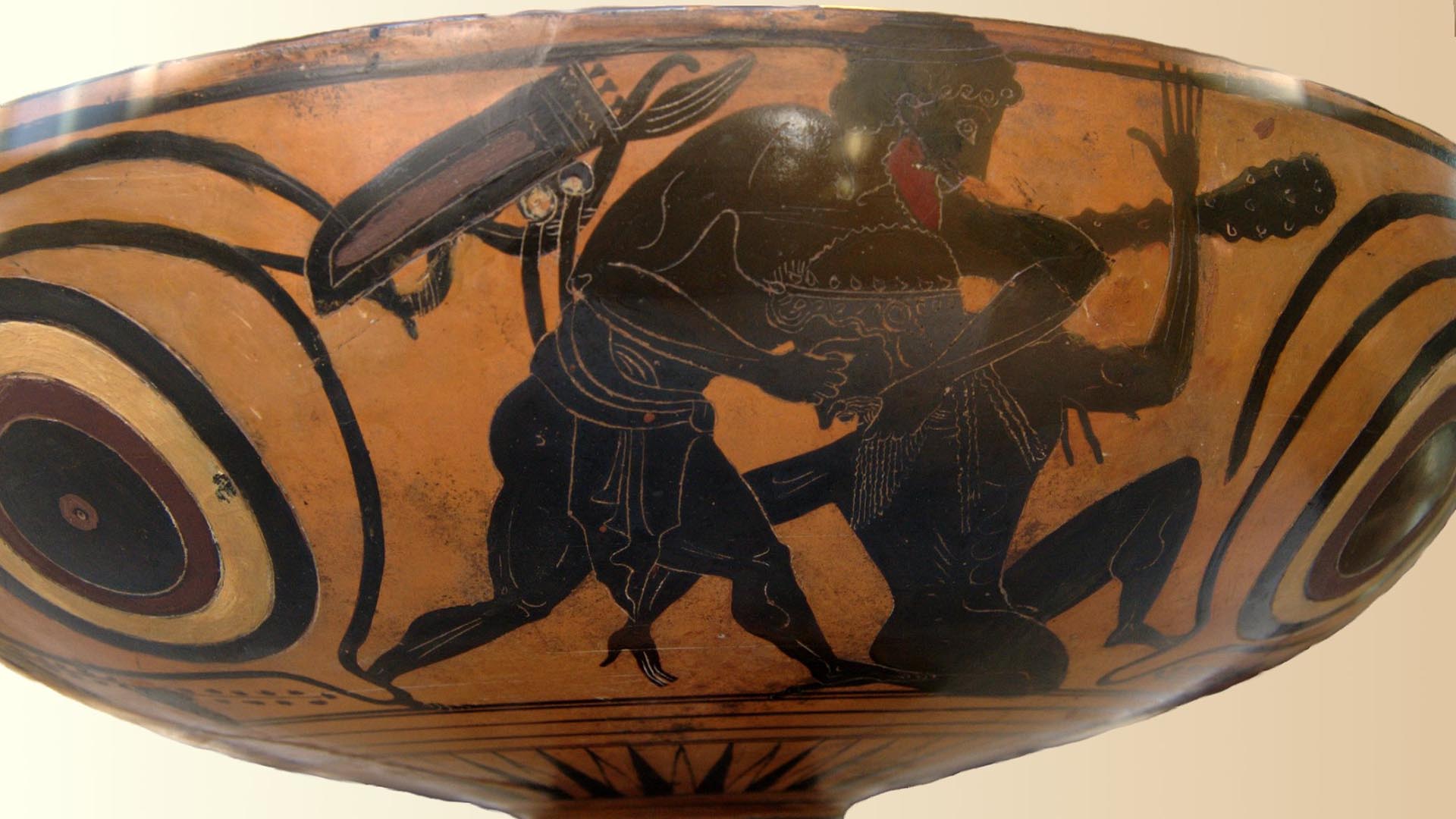
Herakles is identified by visual markers. The first is the presence of his weapons, the club and the bow, which hang up in the background, although these can also be situated off to the side. Second is the lionskin, taken from the Nemean Lion after the hero’s defeat of the creature in his first Labor.
This can either be worn by the hero or, like his weapons, be set aside. While all the accoutrements do not have to be present together in a given scene, at least one characteristic item is always depicted to indicate Herakles. Since the mode of combat is invariably wrestling, Herakles is often but not always shown in the nude (Figure 1 is one of the exceptions).
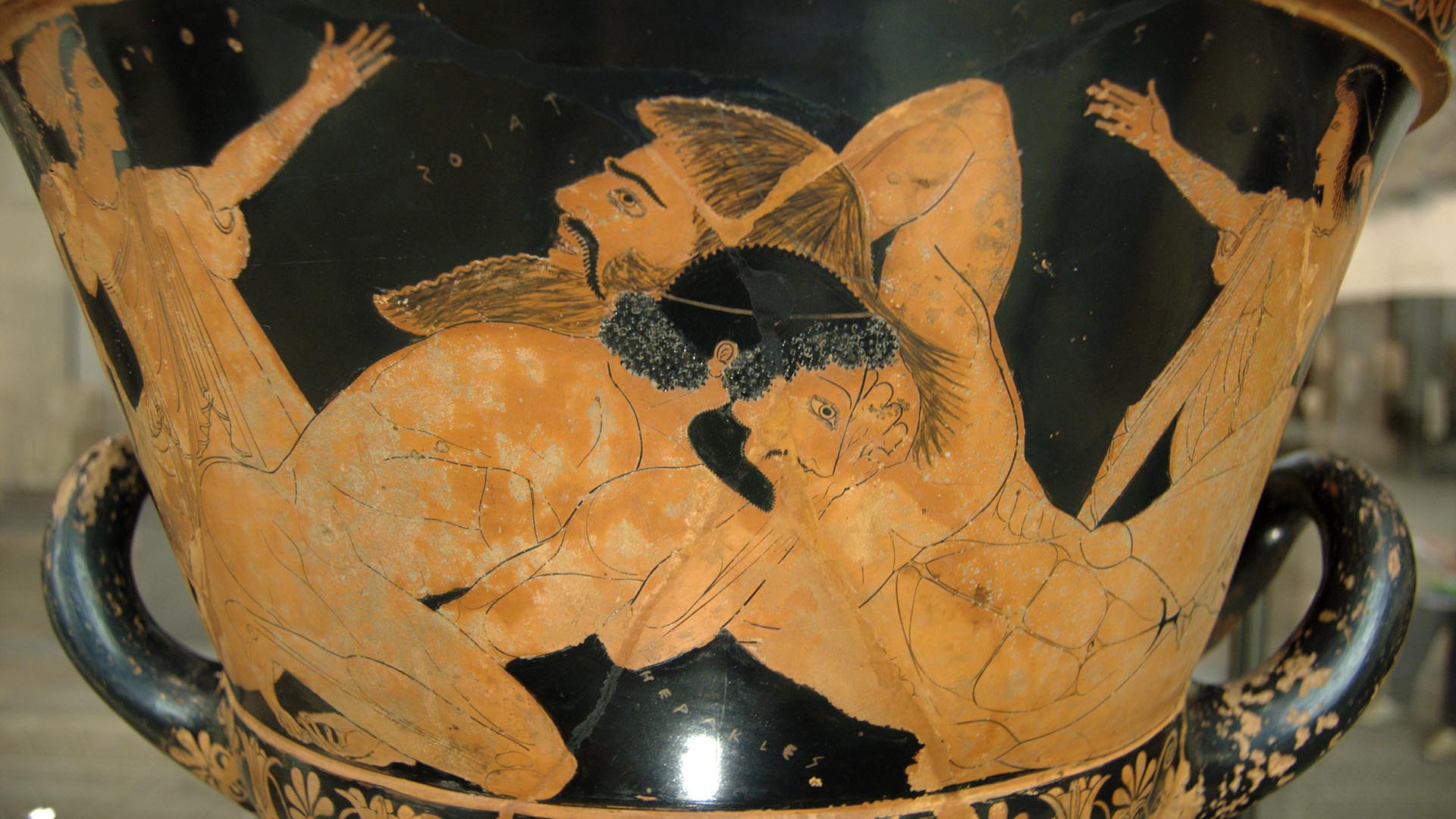
Third and finally is the physical contrast between Herakles and Antaios. Herakles has short hair and a neat beard. Conversely, Antaios, who is always completely nude, has longer hair and a distinctive pointed beard which sometimes is large and unkempt (Figure 1 and Figure 2).
This particular way of emphasizing Antaios’s otherness, especially the beard, comes from Egyptian depictions of Libyans but has received almost no attention in scholarship aside from Sir John Boardman’s observation that Antaios is portrayed “in a manner in which Libyans are often shown in Egyptian art” (Boardman 1999, p. 158).
To expand on Boardman’s point, I highlight a key Egyptian example. On a monumental relief carving at the Temple of Abu Simbel, the pharaoh Rameses II can be seen trampling upon one Libyan and fighting another (Figure 3). Both Libyans possess the distinctive pointed beards that Greek vase-painters enlarged and used as an attribute of Antaios.
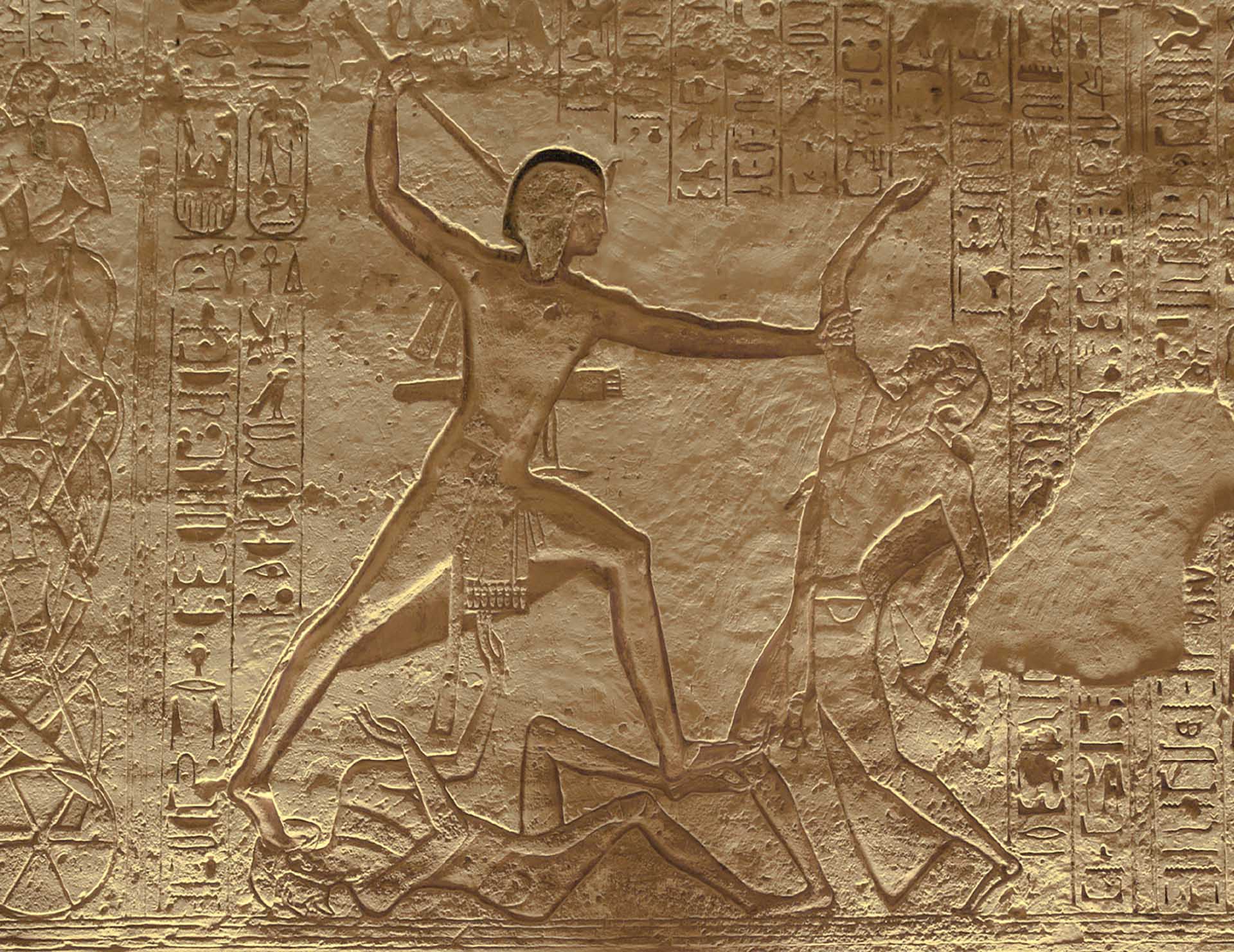
While the vases in Figures 1 and 2 belong to the sixth century BCE and the Abu Simbel relief dates to the thirteenth century BCE, it is large-scale public art and was visible to Greeks in Egypt centuries after its construction. Indeed, there is solid evidence that Greeks saw the wall carving. At Abu Simbel, Greek mercenaries left a range of graffiti in the early sixth century BCE during the reign of the pharaoh Psamtik II, which included their names and ethnics as well as a pun referencing Homeric epic (Dillon 1997, pp. 128-9).
Moving from Libya to Egypt, the Busiris myth has received greater attention from scholars, in part due to the inclusion of Greek ritual implements, such as the sacrificial altar, knife, and grain basket (Van Straten 1995, pp. 47-49). It has also been noted that the name “Busiris” is the Greek translation of the Egyptian place name Pr-Wsir, which means “House of Osiris” and referred to a major town in the Nile Delta (Livingstone 2001, p. 85; McPhee 2006, p. 45).
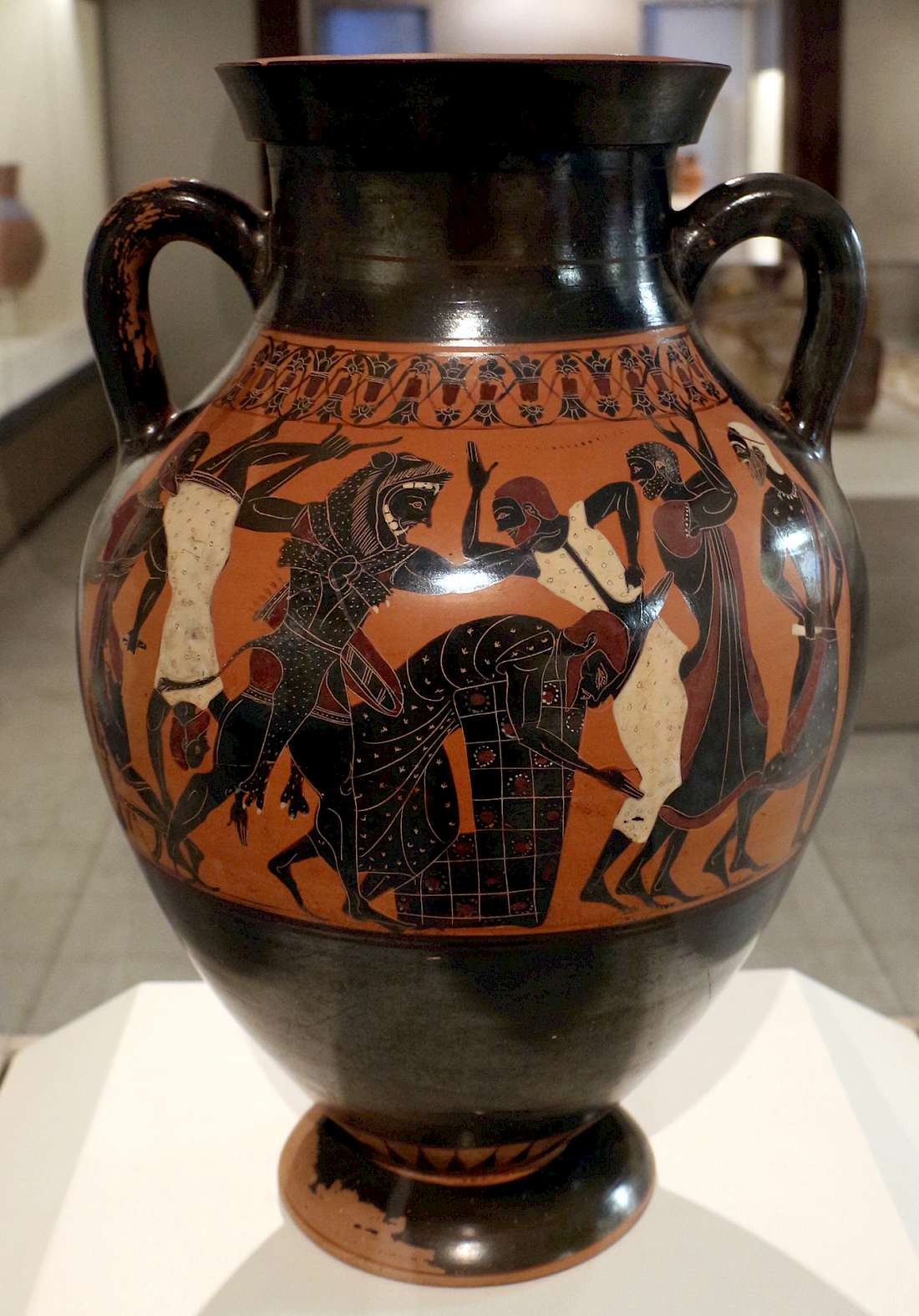
As in the Antaios scenes, the vase-painters adhere to a fairly standard scheme, although the specifics vary. The altar is given a central position, and the figures are grouped around it (Figure 4). Herakles is shown in the process of routing Busiris and his priests. The hero either assaults them with his club or bare hands. In the latter scenario, he can be seen strangling an Egyptian priest and is in the process of using another Egyptian as a weapon in place of his club to assault the unlucky fellow’s comrades (Figures 4 and 5).
The vase-painters used several methods to show the physical difference between Herakles and the Egyptians. In many instances, as in Figure 5, Busiris and his priests are shown as what are meant to be read as black men, a point to which I return in the next section.
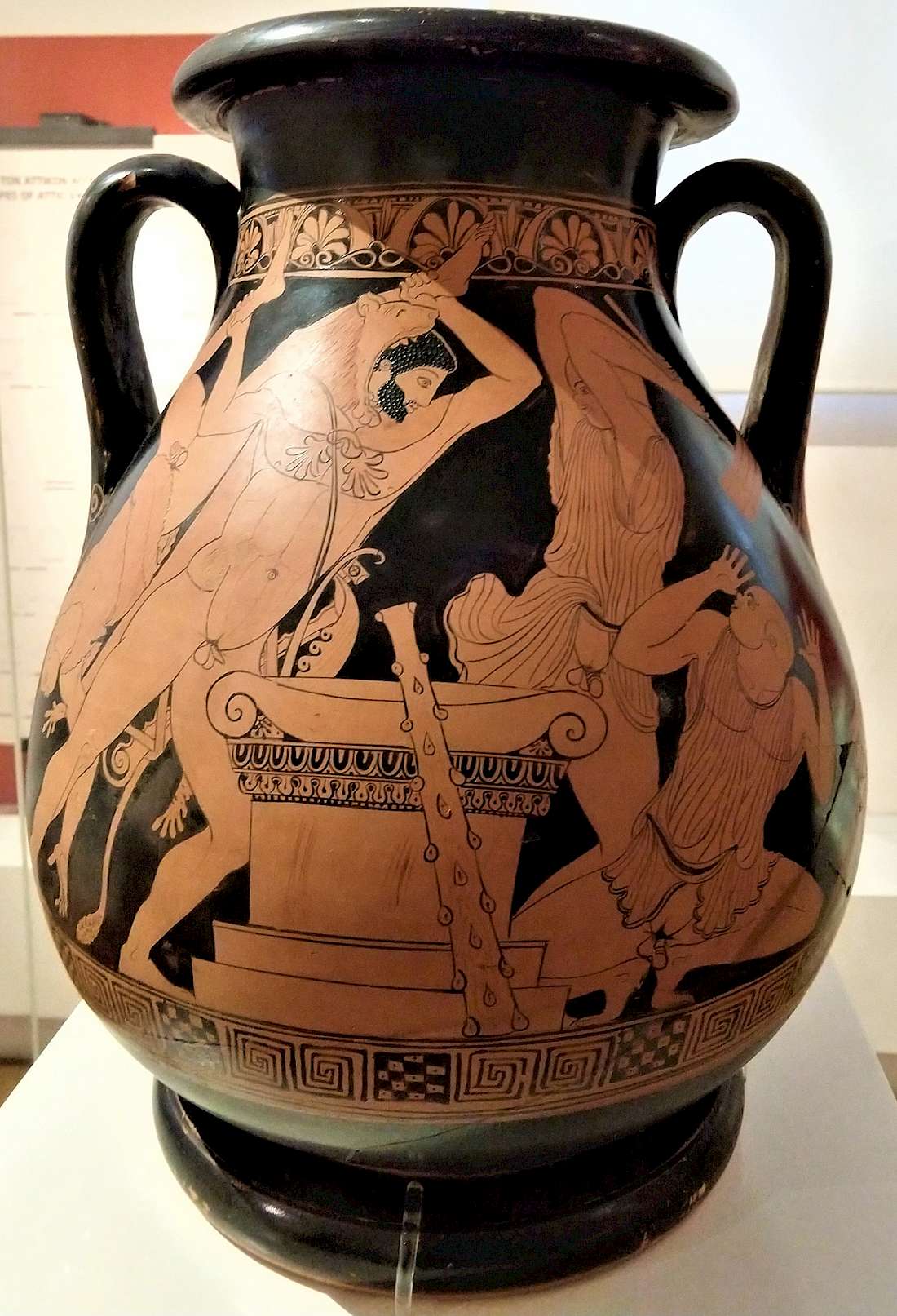
Herakles may or may not be fully or partially nude, but the Egyptians always wear a garment, usually the distinctive kalasiris (Figures 4 and 5). The artist who painted the vase in Figure 5, the Pan Painter, has also highlighted the Egyptian practice of circumcision by making the fabric of the kalasiris flare around their prominent genitalia. This contrasts with Herakles’s own penis, which is smaller and uncircumcised (McNiven 1995, p. 5).
As for Busiris himself, it is not always clear which figure he is, but I believe that this is by design, if we understand that the vase-painters have placed Herakles in the position of the pharaoh. Certainly, there are other points of inversion in the compositions, namely the perversion of human sacrifice, which Herakles himself disrupts by staining the altar of Zeus with the blood of Busiris and his priests.
Sir J.D. Beazley also pointed out almost a century ago that the vase-painters are parodying the Egyptian artistic device of the pharaoh smiting his enemies, where the ruler is shown triumphing over multiple foes; this has been reiterated in later academic literature (Beazley 1926, p. 600; McPhee 2006, p 48).
Specific instances are not provided in these references, so I offer the Temple of Karnak as an example, where a monumental relief of the pharaoh Thutmose III from the fifteenth century BCE employs smiting imagery (Figure 6). Once more the early date of the wall carving might raise objections, but like the Abu Simbel relief it would have been visible centuries later. Moreover, the similarities between the Karnak relief and the Busiris episodes is striking enough that it cannot be a coincidence—the king’s aggressive striding pose, the arm raised to attack wielding a mace, the cowering enemies on the right (Figure 6).
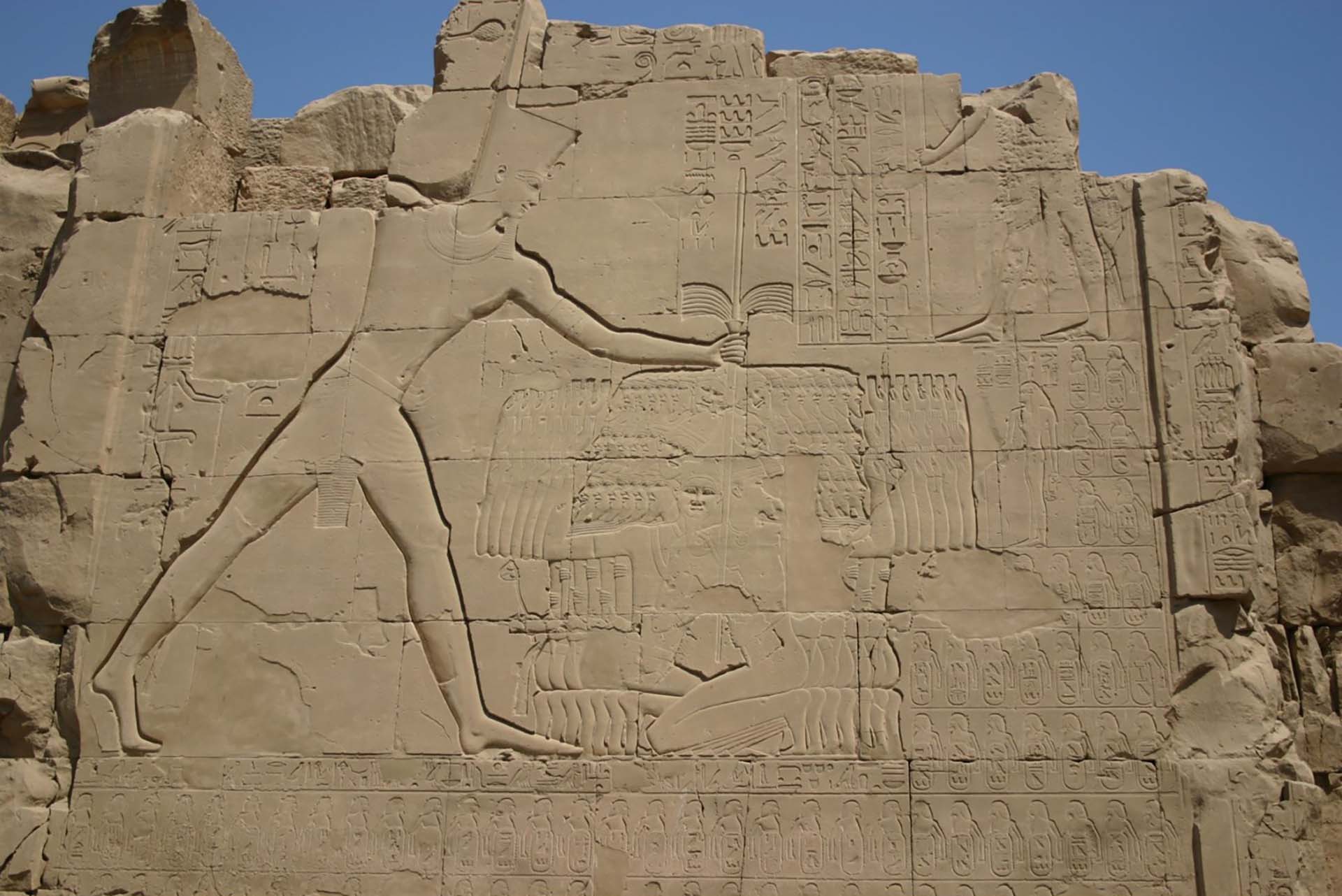
What should now be clear from the exploration of Antaios and Busiris the myths in Greek vase-painting is that there are two things happening: the artists do not present a monolithic image of the so-called “other” in North Africa and the images must be understood in relation to already-ancient conventions borrowed and adapted from Egyptian art.
The settings of “Libya” and “Egypt” in vase-painting are firmly in the heroic realm, but the Greek experience of both Libya and Egypt was very real. Consequently, it is impossible to interpret the images without recognizing that the vase-painters understood both as distinct places, even if as locales situated toward the edges of the known world (oikumene).
Antaios and Busiris: otherness in Egyptian and Greek eyes
At this point I want to expand on what is the most arresting aspect of the Antaios and Busiris episodes, artistically and perhaps ideologically – that they are constructions fashioned in the shadow of Egypt. Broadly speaking, the nature of the relationship between Egyptian art and Greek art remains a subject of debate (Tanner 2003, p. 138), but treating portrayals of “the other” as an expression of attitudes pioneered by the ancient Greeks is untenable.
By the time that depictions of foreigners began to make their way into Greek art during the Archaic period, Egyptians had been distinguishing themselves from foreign others such as Asiatics, Libyans, and Nubians in art since the third millennium BCE (Smith 2003, pp. 22-23).
And although Egypt itself was seen as foreign and “other” in the Greek imagination this understanding was a complicated one. It was recognized that Egypt possessed an impressive civilization whose antiquity stretched far into the distant past, long before the foundation of any Greek city-state. If we set aside the Greek discomfort with monarchy, the insertion of Herakles into the position of the pharaoh in vase-painting allows for a reading where Greeks have placed themselves visually into the storied history of Egypt.
Another issue that merits further discussion is the physical character of the Egyptians on the Busiris vases. The literature on the so-called race of the ancient Egyptians has a long and sordid history that cannot be addressed in full here, but suffice it to say that in the nineteenth century it became entangled with the race science of the day. Ancient Egypt was subjected to a systematic whitening as part of a larger effort to justify the enslavement of people of African descent by denying any association between civilization and black people (Bernasconi 2007, p.12).
Whether such concepts as race and racism even existed in the ancient Mediterranean remains a subject of debate (Isaac 2004, pp. 4-5; McCoskey 2012, pp. 47-49; Kennedy et al. xiii-xv; Jensen 2018, pp. 14-16) and racial categories such as black and white are modern social fabrications that would have held no meaning in antiquity (Dee 2004, pp.163-4; Smith 2018, pp.18-19).
It is clear, however, that ancient Greek vase-painters, even accounting for the distortions and conventions inherent to their medium, conveyed Egypt as place that was home to people who in modern terms would be considered black.
Greece in the wider Mediterranean
What, ultimately, is the takeaway?
By focusing on Herakles’s confrontations with Antaios and Busiris, I have attempted to present a more nuanced reading of just two of the myths that belong to a broader category of representations of Africans in ancient Greek vase-painting. The imagery is superficially violent, but I hope to have shown that there are multiple complexities present in the genesis of this iconography.
The preceding discussion was only made possible by looking beyond the boundaries of Greek art and the conventional framing of the Greek and barbarian dichotomy. That the ancient Greeks were part of a larger Mediterranean world is not a novel idea. Ancient Greece encompassed many hundreds of individual city-states and other settlements from Spain in the west to Turkey in the east, from Libya and Egypt in the south to the shores of the Black Sea in the north.
Goods and people moved along extensive trade networks in all of these directions, and the material and visual evidence bears out that the exchanges could be artistic as well. The vases decorated with the Antaios and Busiris scenes could not have been produced in the absence of these exchanges.
If we are to achieve a more complete understanding of ancient Greece and Greek art, it is necessary to fully embrace approaches that account for the interconnected reality of its Mediterranean milieu.
Further reading
- J.D. Beazley, “Early Greek Art,” in: J.B. Bury, S.A. Cook, and F.E. Adcock (eds.), The Cambridge Ancient History Volume 4 (1926), pp. 579-609.
- R. Bernasconi, “Black Skin, White Skulls: The Nineteenth Century Debate Over the Racial Identity of the Ancient Egyptians,” Parallax 13 (2007), pp. 6-20.
- J. Boardman, The Greeks Overseas (1999).
- F. Brommer, Heracles: The Twelves Labors of the Hero in Ancient Art (1986).
- J. Dee, “Black Odysseus, White Caesar: When did ‘White People’ Become White?”, The Classical Journal 99 (2004), pp. 157-167.
- M. Dillon, “A Homeric Pun from Abu Simbel (Meiggs and Lewis 7a)”, Zeitschrift für Papyrologie und Epigraphik 118 (1997), pp. 128-130.
- B. Isaac, The Invention of Racism in Classical Antiquity (2004).
- E. Jensen, Barbarians in the Greek and Roman World (2018).
- F. Lissarrague, “The Athenian Image of the Foreigner”, in: T. Harrison (ed.), Greeks and Barbarians (2002), pp. 101-124.
- N. Livingstone, A Commentary on Isocrates’ Busiris (2001).
- D.E. McCoskey, Race: Antiquity and Its Legacy (2012).
- T. McNiven, “The Unheroic Penis: Otherness Exposed”, Notes in the History of Art 15 (1995), pp. 10-16.
- I. McPhee, “Herakles and Busiris by the Telos Painter”, Antike Kunst 49 (2006), pp. 43-56.
- S.T. Smith, Wretched Kush: Ethnic Identities and Boundaries in Egypt’s Nubian Empire (2003).
- S.T. Smith, “Constructions of Self and Other in Ancient Egypt”, Journal of Egyptian History 11 (2018), pp. 113-146.
- E. Stafford, Herakles (2012)
- J. Tanner, “Finding the Egyptian in Early Greek Art”, in: R. Matthews and C. Roemer (eds.), Ancient Perspectives on Egypt (2003), pp. 115-143.
- F.T. van Straten, Hiera Kala: Images of Animal Sacrifice in Archaic and Classical Greece (1995).
